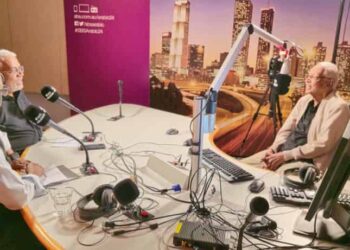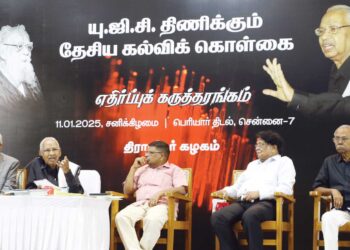Dr. Ambedkar Academy, the People’s Educational Trust, organized Dr.Ambedkar Endowment lecture at Madras University Chennai on 23rd February 2016. Dr.K.Veeramani, President, Dravidar Kazhagam and Chancellor, Periyar Maniammai Univeristy delivered the Endowment lecture on the topic, “Dr.Ambedkar Crusader for Human Rights and Emancipation of the suppressed sections of the society”.
Self Respectful A.Padmanabhan IAS (Rtd) former Governor of Mizoram, and Chief Patron and Advisor of the Trust presided over the lecture meeting. Mr.C.Chellappan IAS (Rtd), the Managing Trustee welcomed the dignitaries and the audience. Mr.J.Ramalingam, Secretary General of the Trust delivered the introductory address. Dr.S.Devadoss, Joint Managing Trustee addressed briefly prior to the delivery of the endowment lecture. Dr.P.David Jawahar, Registrar University of Madras felicitated. Dr.A.David Ambrose, Professor and Head, Department of Legal Studies proposed vote of thanks.
Endowment Lecture
Dr.K.Veeramani, delivered the endowment lecture with the aid of power point presentation. The excerpts of the lecture are as under:
“Can you see anywhere in the world the abhorring practice? Yes; the practice prevailing in this land is ‘unseeability’ worse than ‘untouchability’. In the name of god and religion human beings are dubbed as low caste. In this holy land only, humans are born in caste, live in caste, die in caste and bequeath caste. Humans are indoctrinated with the vicious Varnashra Dharma and its social injunctions. No where in the world such a sort of social system exists. People are identified in the name of caste not only when they are alive, but even afterwards. Yes; even after death caste continues and discrimination continues. Caste discrimination and atrocities continue despite the prevalence of Indian Constitutional Law and Protection of Civil Rights Act 1955, duly amended later. Laws are silent spectators; Law enforcing authorities remain action less, hand tied, pathetic and dumb watching agencies. To overcome such atrocities and to live as respectable human beings, it is time to turn to the twin-social revolutionaries, Thanthai Periyar E.V.R and Babsaheb Dr.B.R.Ambedkar, who lived as the torch bearers of social transformation and so even after their demise they live through their progressive ideologies.
Dr. Ambedkar was an exemplary crusader; not a reformer but revolutionary; not only a visionary but also a missionary. He dedicated his entire life to redeem the vast majority of suffering millions from ‘dehumanisation’, The missionary life of Dr.Ambedkar aimed at the establishment of human dignities, development of self respect and attainment of self-salvation. In a nutshell, the missionary aimed at ‘man making’ himself accomplish it. The undaunted warrior advocated the panacea commandments ‘Educate, Agitate and Organize’. This is the only route to the human dignity of the suppressed, and the oppressed sections of the society through the methodology they have to redeem and restore their human dignity.
The path is arduous; the social disease is worse. It was diagnosed rightly and treatments have to be given accordingly. Periyar EVR never believed in ‘Physician’s cure’ but only in the ‘Surgeon’s cure’. Dr.Ambedkar educated the suppressed through thought-provoking speeches. He emancipated the marginalised masses by publishing a magazine in Marathi viz. Mook Nayak meaning ‘Voice of the Dumb’. In the first issue of the ‘Mook Nayak’ he wrote, “India is a home of inequality. Hindu society is just like a tower, which has several storeys without a ladder or entrance. One has to die in the mould in which he was born”.
Ambedkar Proclaimed his personal philosophy as follows :
“Every man should have a philosophy of life, for everyone must have a standard by which to measure his conduct; and philosophy is nothing but a standard by which to measure”. Besides Ambedkar stated the roots of his philosophy in religion as “Positively, my social philosophy may be said to be enshrined in three words: Liberty, Equality and Fraternity”. Further he said, “Let no one however, say that I have borrowed my philosophy from the French-Revolution. I have not. My philosophy has roots in religion and not in political
science. I have derived them from
the teaching of my Master, the Buddha.”
Inspired by the Kerala – Vaikom Agitation
Ambedkar derived inspiration for Mahad Satyagraha from the Kerala – Vaikom agitation led by Periyar demanding entry of the marginalised untouchables in the roads adjoining the temple, which was denied to them till then. This was the first agitation, launched to acquire human rights for the downtrodden.
Dhananjay Keer, who wrote the biography viz. Dr.Ambedkar: Life and Mission, quotes the mentioning of the Vaikom agitation in Mook Nayak “the most outstanding event of the year concerning the struggle of the Depressed Classes was the Satyagraha or the passive resistance sponsored by Ramaswami Naicker, a non-Brahmin leader, at Vaikom in the Travancore State for vindicating the rights of the untouchables to use a certain road to which they were forbidden entry. Its moral pressure and the spirit of righteous assertion had a tremendous effect, and the orthodox Hindus, for a while, regained their civic sense and sanity, and the road was thrown open to the Untouchables. Ambedkar was watching these developments very carefully. He referred to the Vaikom struggle, a few months later, very touchingly in one of his editorials, on the eve of the Mahad Satyagraha. These were notable events. Coming events cast their shadows before!”
Burning Manusmriti : Dr.Ambedkar opposed stoutly Manusmirit, the inhuman code of Hindu Religion. “The Bonfire of Manusmriti was quite intentional. We made a bonfire of it because we view it as a symbol of injustice under which we have been crushed across centuries. Because of its teaching, we have been ground down under despicable poverty and so we made the clash, staked all, took our lives in our hands and performed the deed”, Ambedkar said.
The Techniques of Supression : “If the common man belonging to the servile classes in India is today so fallen, so degraded, so devoid of hope and ambition, it is entirely due to the Brahmins and their philosophy. The cardinal principles of this philosophy of Brahminism were SIX- to use correct expression techniques of suppression.
• Graded inequality between the different classes.
• Complete disarmament of the Shudras and the Untouchables;
• Complete ban on the education of the Shudras
and the Untouchables;
• Total exclusion of the Shudras and the Untouchables from places of power and authority,
• Complete prohibition against the Shudras and the Untouchables acquiring property and,
• Complete subjugation and suppression of women.
Inequality is the official doctrine of Brahminism and the suppression of the lower classes aspiring to equality has been looked upon by them and carried out by them, without remorse as their bounden duty”
Graded inequality prevents revolution against Brahminism : “None have realised that in addition to equality and inequality there is such a thing as graded inequality. Yet inequality is not of so dangerous as graded inequality. Inequality carried within itself the seeds of its own destruction. Inequality does not last long. Under pure and simple inequality two things happen. It creates general discontent, which forms the seed of revolution. Secondly it makes the sufferers combine against a common foe and on a common grievance. But the nature and circumstances of the system of graded inequality leave no room for either of these two things to happen. The system of graded inequality prevents the rise of general discontent against inequity. It cannot become the storm centre of revolution. Secondly the sufferers under inequality become unequal both in terms of the benefit and the burden. There is no possibility of a general combination of all classes to overthrow the inequity… Why there has been no revolution against Brahminism and its inequities is due entirely to the principle of graded inequality.” Brahminism was the term that the anticaste movement preferred over ‘Hinduism’. By Brahminism, they didn’t mean Brahmins as a caste or a community. They meant the domino effect, what Ambedkar called the
“infection of imitation”, that the caste that first “enclosed” itself – the Brahmins set off. “Some closed the door,” he wrote, “others found it closed against them.” as it moves down the caste ladder, but never quite disappears. It has created what “infection of imitation”, like the half-life of a radioactive atom, decays exponentially Ambedkar describes as a system of “graded inequality” in which “there is no such class as a completely unprivileged class except the one which at the base of the social pyramid. The privileges of the rest are graded.
Even the low is privileged as compared with lower.
Each class being privileged, every class is interested in maintaining the system.”
Thanthai Periyar – Babasaheb Ambedkar Contacts and Meets
1937: First contact between the leaders was on ideological ground. Thanthai Periyar was the first in contacting Dr.Ambedkar and publishing in Tamil. ‘Annihilation of Caste’, the Presidential address, prepared by Dr.B.R.Ambedkar, but NOT DELIVERED at Jat – Pat – Dodak Mandal, Lahore in 1936
1940 – Bombay : On 6.1.1940, Periyar met Ambedkar and discussed the prevailed political scenario for more than two hours. On 7.1.1940, Ambedkar hosted a tea party to Periyar. Periyar and Ambedkar were taken in procession and they addressed a public meeting at Dharavi. Arignar Anna translated Ambedkar’s English speech into Tamil and Periyar’s Tamil speech into English for the understanding of both the leaders. On 8.1.1940 Periyar met Mohammed Ali Jinnah and Dr.Ambedkar and joint discussion was held about the political climate, prevailed then.
1944 – Madras : On 23.9.1944 – Ambedkar met Periyar, leader of Justice Party and had a long discussion on the political problems in Madras. Dr.Ambedkar spoke at a Luncheon party, given in
his honour by P.Balasubramaniam at Hotel Connemara, Madras. Analysing the causes of the downfall of the
non-Brahmin party, Ambedkar said, “Many of the people in the non-Brahmin party tried to become second class Brahmins. They have not abandoned braminism which they are slavishly aping and holding to its deal. Here exists the need for a good leader, good organisation and a clear cut ideology for the non-Brahmin party”
1954 – Rangoon : Periyar and Ambedkar attended jointly The World Buddhist Conference at Rangoon, Burma (Myanmar)







